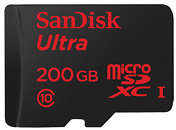- Joined
- Oct 9, 2007
- Messages
- 47,837 (7.39/day)
- Location
- Dublin, Ireland
| System Name | RBMK-1000 |
|---|---|
| Processor | AMD Ryzen 7 5700G |
| Motherboard | Gigabyte B550 AORUS Elite V2 |
| Cooling | DeepCool Gammax L240 V2 |
| Memory | 2x 16GB DDR4-3200 |
| Video Card(s) | Galax RTX 4070 Ti EX |
| Storage | Samsung 990 1TB |
| Display(s) | BenQ 1440p 60 Hz 27-inch |
| Case | Corsair Carbide 100R |
| Audio Device(s) | ASUS SupremeFX S1220A |
| Power Supply | Cooler Master MWE Gold 650W |
| Mouse | ASUS ROG Strix Impact |
| Keyboard | Gamdias Hermes E2 |
| Software | Windows 11 Pro |
SanDisk Corporation, a global leader in flash storage solutions, today introduced the 200GB SanDisk Ultra microSDXC UHS-I card, Premium Edition, the world's highest capacity microSD card for use in mobile devices. In just one year after introducing its record-breaking 128GB SanDisk Ultra microSDXC card, SanDisk has increased storage capacity by 56% within the same fingernail-sized form factor. Keeping up with the demands of today's mobile users, the new card provides the freedom to capture, save and share photos, videos and other files without worrying about storage limitations.
"Mobile devices are completely changing the game. Seven out of 10 images captured by consumers are now from smartphones and tablets. Consumers view mobile-first devices as their primary means for image capture and sharing, and by 2019 smartphones and tablets will account for nine out of 10 images captured," said Christopher Chute, Vice President, Worldwide Digital Imaging Practice, IDC. "As the needs of mobile users continue to change, SanDisk is on the forefront of delivering solutions for these demands as is clearly illustrated through their growing portfolio of innovative products, including the new 200GB SanDisk Ultra microSDXC card."

SanDisk achieved this capacity breakthrough by leveraging the proprietary technology developed last year for the 128GB SanDisk Ultra microSDXC card, and creating a new design and production process that allows for more bits per die.
"We continue to push technology boundaries to deliver record-breaking solutions that transform the way consumers use their mobile devices," said Dinesh Bahal, vice president, product marketing, SanDisk. "By focusing on achieving new capacity and speed milestones, we are able to deliver trusted mobile memory solutions that give consumers the freedom to never stop capturing, saving, or sharing - with the benefit of fast speeds to transfer it all quickly."
Ideal for Android smartphone and tablet users, this Premium Edition microSD card combines the world's highest capacity and blazingly fast transfer speed of up to 90MB/s to deliver premium performance. At this transfer speed, consumers can expect to move up to 1,200 photos per minute2.
Through SanDisk's updated Memory Zone app users will have even greater control over their mobile device's memory storage. In the Memory Zone app, users can engage the OptiMem app feature which monitors the phone's memory levels to inform users whenever the internal memory falls below a user-defined threshold. Once this threshold is reached, the OptiMem app feature will automatically transfer some of their old photos and videos to their microSD card, leaving them with more internal memory to continue making memories. The app, available for free download from the Google Play store, is compatible with most Android-powered devices and allows users to easily locate, organize, transfer and back up data.
Pricing and Availability
The 200GB SanDisk Ultra microSDXC UHS-I card, Premium Edition, features a ten-year limited warranty and will be available worldwide in Q2 at an MSRP of $399.99.
View at TechPowerUp Main Site
"Mobile devices are completely changing the game. Seven out of 10 images captured by consumers are now from smartphones and tablets. Consumers view mobile-first devices as their primary means for image capture and sharing, and by 2019 smartphones and tablets will account for nine out of 10 images captured," said Christopher Chute, Vice President, Worldwide Digital Imaging Practice, IDC. "As the needs of mobile users continue to change, SanDisk is on the forefront of delivering solutions for these demands as is clearly illustrated through their growing portfolio of innovative products, including the new 200GB SanDisk Ultra microSDXC card."

SanDisk achieved this capacity breakthrough by leveraging the proprietary technology developed last year for the 128GB SanDisk Ultra microSDXC card, and creating a new design and production process that allows for more bits per die.
"We continue to push technology boundaries to deliver record-breaking solutions that transform the way consumers use their mobile devices," said Dinesh Bahal, vice president, product marketing, SanDisk. "By focusing on achieving new capacity and speed milestones, we are able to deliver trusted mobile memory solutions that give consumers the freedom to never stop capturing, saving, or sharing - with the benefit of fast speeds to transfer it all quickly."
Ideal for Android smartphone and tablet users, this Premium Edition microSD card combines the world's highest capacity and blazingly fast transfer speed of up to 90MB/s to deliver premium performance. At this transfer speed, consumers can expect to move up to 1,200 photos per minute2.
Through SanDisk's updated Memory Zone app users will have even greater control over their mobile device's memory storage. In the Memory Zone app, users can engage the OptiMem app feature which monitors the phone's memory levels to inform users whenever the internal memory falls below a user-defined threshold. Once this threshold is reached, the OptiMem app feature will automatically transfer some of their old photos and videos to their microSD card, leaving them with more internal memory to continue making memories. The app, available for free download from the Google Play store, is compatible with most Android-powered devices and allows users to easily locate, organize, transfer and back up data.
Pricing and Availability
The 200GB SanDisk Ultra microSDXC UHS-I card, Premium Edition, features a ten-year limited warranty and will be available worldwide in Q2 at an MSRP of $399.99.
View at TechPowerUp Main Site




